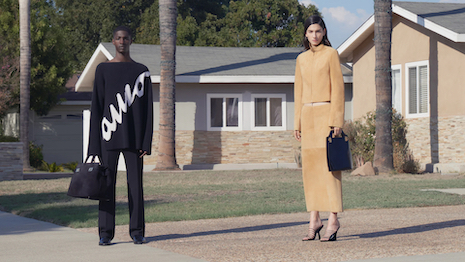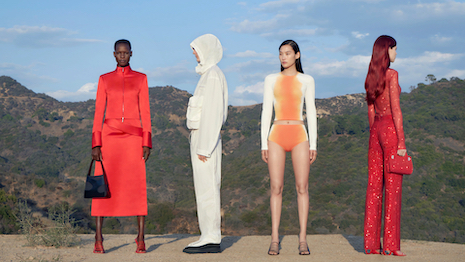Just weeks after introducing reinvigorated branding, and in the aftermath of a buzzy fashion week debut, Italian leather goods company Ferragamo is moving full speed ahead with a new release.
The brand is back with a monthlong multichannel activation equal parts experimental and experiential in nature. An early launch of select styles from the brand's spring/summer 2023 collection commences in conjunction with an immersive online shopping space, an exclusive ecommerce partnership and more, all available for a limited time only.
“Ferragamo's proposed ‘go-to-market’ strategy is not exactly the ‘see-now, buy-now' model," said Thomaï Serdari, author of Rethinking Luxury Fashion and director of fashion and luxury MBA at NYU Stern, New York.
“The brand has preselected the items they will make available to accomplish several things: 1. generate sales 2. generate excitement and 3. measure the size of the collection to be produced fully in the spring," she said. “This is a great strategy that will allow Ferragamo to ‘measure’ excitement and demand before the collection's full release in the spring.”
Ms.Serdari is not affiliated with Ferragamo, but agreed to comment as an industry expert.
Ferragamo firsts
From Nov. 4 to Nov. 30, Maximilian Davis fans can gain access to an edited preview of debut pieces from the newly-instated creative director's inaugural house offering.
From glittering garments that homage Salvatore Ferragamo's own inventions for the likes of Marilyn Monroe, to innovative fabrications and “second-skin suedes," Ferragamo appears fully invested in its new era.
Design firsts notably include an array of loafers, boots and sandals, while handbags are reiterated, with roots in the archives.
“I wanted to pay tribute to Salvatore’s start by bringing in the culture of Hollywood — but new Hollywood. Its ease and sensuality; its sunset and sunrise,” said Maximilian Davis, creative director at Ferragamo, in a statement.
The early springtime capsule is now available online at Ferragamo.com, as well as in-store.
“Fashionistas are already very excited to see Maximilian Davis as the Head Creative of Ferragamo, a move that makes the slightly 'tired' brand younger, more inclusive, and more culturally sensitive," NYU Stern's Ms. Serdari said.
Ferragamo is merchandising its moment in more ways than one.
 Engagement and interaction with exclusive content and elements such as a mood board-turned-personalized digital pathway is the name of Ferragamo's game. Image courtesy of Ferragamo
Engagement and interaction with exclusive content and elements such as a mood board-turned-personalized digital pathway is the name of Ferragamo's game. Image courtesy of Ferragamo
First up to mark the occasion is “The World of Ferragamo," a new, immersive virtual space inviting users to discover and shop its latest launch. Inside, a central hall comprises four corners dedicated to the shoe, handbag, womenswear and menswear product categories, respectively.
“An online 3D space complements the idea that the brand is shifting to a younger clientele," Ms. Serdari said.
“Without offending any of its existing customers, the brand can create an immersive environment that clearly communicates the brand's DNA and enhances the excitement that comes with new product."
On its ecommerce end, after launching a global integrated partnership to boost digital innovation capabilities and reach new consumer segments in August of this year, the company continues its standing partnership with luxury online retailer Farfetch, teaming up with the tech-forward platform once more as the drop's exclusive retail partner.
“The decision to partner with Farfetch is a sound one as well because Farfetch is a destination marketplace for fashion enthusiasts who are looking for unique pieces," Ms. Serdari said.
With such dynamic digital elements, the perks of shopping the capsule live must be carefully considered. Ferragamo's answer lies in the trimmings.
 Select styles from the brand's spring/summer 2023 collection. Image courtesy of Ferragamo
Select styles from the brand's spring/summer 2023 collection. Image courtesy of Ferragamo
Upon checkout at one of the 17 boutiques worldwide that are carrying the limited-run — spanning stores including London Old Bond Street, Paris Avenue Montaigne, Milan Women’s and Milan Men’s, Dubai Mall, Tokyo, New York Fifth Avenue and Sao Paulo, to name a few across varying regions — customers receive special packaging, marking a purchase from the early preview as easily-identifiable.
“This strategy has worked for limited edition releases," she said.
“One that comes to mind, and which is very popular with Gen Z, is the Omega/Swatch collaboration which was made available only in very few bricks-and-mortar boutiques and has resulted in the models being sold out consistently."
Layered limited-edition elements work to drive hype all around.
“There will be several items that will not be made available on Farfetch or through the limited boutiques," Ms. Serdari said.
“However, Ferragamo will certainly continue communicating about them even if they have not gone into production yet," she said. “The brand is adopting a bold new strategy in going-to-market."
“Just based on the description of how this initial 'drop' is going to happen, one assumes that Ferragamo is deliberately holding back on releasing everything now, precisely because it wants to maintain the mystery and excitement that comes with the revelation of a full collection."
Seasonality and sustainability
The fashion industry has long been interested in unconventional product drops and rollout models, but rarely is such a masterful mix of multichannel tactics witnessed at once.
Ferragamo manages to strike that balance, making the case for a more intuitive merchandising model and resurfacing considerations for the value of “see-now, buy-now," particularly as it relates to sustainability, a segment top-of-mind for a sizable group of luxury leaders, and a concept reopened in recent years at the hands of the COVID-19 crisis.
The global health pandemic halted supply chains, impacting the availability of luxury materials. Italian leather topped many a missing list.
“What COVID revealed was the need to reinstate proximity between the creative centers of brands and their production facilities," Ms. Serdari said.
Posited as a potential solve — one that has been floated for decades by advocates for a slower industry and smaller brands without the mega-means for production alike — “see-now, buy-now” calls for a closer alignment between fashion shows and the in-store availability of collections, essentially asking that designers realign calendars according to real-time seasons.
The practice is seeing an increase in both expressed support and trial from prominent fashion entities.
“One of the challenges that the 'see-now, buy-now' model has tried to solve is to allow brands to avoid overproducing," Ms. Serdari said.
“This happens because only items that have been “ordered/purchased" go into production," she said. “This method ensures that the brand doesn't overproduce, doesn't lock capital in merchandise that might eventually go unsold, and doesn't encumber the planet with additional inventory that is disposed of."
As a well-resourced operation (see story) with tight supplier networks, Ferragamo over indexes in potential here, in part due to its production structure and as shown by its most recent drop.
“For sure, if many more brands followed this model, some of the burdens that result from the internal structure of the fashion industry would be eliminated," Ms. Serdari said.
“However, not all brands are in a position to do this," she said. “In fact, this is precisely why I think Ferragamo's move is brilliant."
“Ferragamo is very close, in a real geographic sense, to the factories where they produce their garments and in that sense, they can better, and even fully, control the economics of these factories."
Non-luxury players, and even luxury players based outside of European manufacturing epicenters, are unable to operate as seamlessly.
“Brands that don't own their factories or don't have the partnerships that allow them to have a position of control as to how production evolves are also at a disadvantage," she said.
The extra control brings a fair level of oversight to order quantities, working to reduce unnecessary waste. Additional sales insights garnered from collection pre-runs like this one help to generate more accurate estimates of interest, enabling Ferragamo to get as close to a 1:1 ratio of items produced to luxury buyers as possible.
Ferragamo's production model could provide a blueprint for alleviating fashion's impact on the planet — the moment strikes as particularly pertinent, as all eyes follow the brand's new direction (see story).
“Climate change is real," Ms. Serdari said.
"Unfortunately, the idea of seasonality has already gone out the window purely because we are moving into an age for one or two long seasons," she said. “Why stick to a model of promotion and sales that is anchored in climate and market conditions of the previous century?"
“A brand like Ferragamo is using the strategy to genuinely test the waters, measure Maximilian's impact on the younger generation of fashionistas, and adjust the rest of the collection which will be addressing both their existing customer base and the new one they hope to acquire — it is a very well-thought-out strategy that appears respectful of the environment as well."
{"ct":"a0Y2MLNKZMpSd8fdioxfb2\/QQMQTlsFXOrkOGilR3Ct\/25jXX4QM2ojuCIjdsOoYNitsQ7h560TlQAOA2dMFL7U2bMqh2jM5zinTToQ9S\/3s6kuUJ8ZoDrQMFWe88fbVPZMXUOUATOUTpnTOYF8DSA9EULOUuEj2rJJiQjHRBR8x39lv5C66qBlBGSTJNgPWp1FGGc9gl+mCGUC1rEr7+USKddrTB0Td9d6XiGxP7CkPgc4S2cAUQv+fnJHAJU0Y7tiPxvKj\/lAFQXFOwBHPkdssFnptMldEAt6e9LOLoo0mzH4zgnSBujadz\/M3DRkYN7J3YtaVCRAjKOWbAdOOkp2DZ4EjxupIq5q2poY9iW5ZE42aJNOmwMTgYiNNvTUPsN5tfQ3szqLu5RD9AjLo9p+VtTDLmH528mCcaxNHpOmAH9iZSTpoYnC3oaNNiZCfoov1ShQa4h5phgLtsGC7rImBUNxHQEidTpJCdwxiEDGjJNg61ock5IYMhfFCg134z79aVdRFz7iEknSvDXFPK1qkaWcwiihRSKNceR30b56lsWH9pBog4rBSPtxFpTnOXU4uNGzZECFFvkksiJM6d2FF8VSO7ZS9xb6w9kc8TYlwahRpgO+00703Z7MJ7kqU4x1wHQA7wyq\/fCnk9woT9pUkokvUhTbO6qWvh\/L3KwW1Fnt0uX1w1xpZcgd53viIhTTTRo1j3HyDN+pVkeKXioqEKeHjsCc\/1nlzu67AzWu+ZN+6uSoaKMiun+PKSOPCQ0CkJF0iKZcZsV4UuLsljjhO3HrMb4cgm2fxh0kq0ESLi6UuBh\/L93dhwcfmUG0OY42bvIDcTG\/\/qi1sbVFayCWgRuiwO0mbR7OTdylEPjWE7tUdZeRD45JurQLFNraVnEr2NxLOhLT\/5SBRzhEvp9BENlYcxFbuB3lPjdRMJhl5Ru8EzB7jtVhuvBVzgo\/R1Clma5ElQqsNx7qCdFiJQVEEtjFi6ZlOLUg\/+iTG4oeieymb8SydS4OGLic8P7fXez+j4kHlqihMLN9cydyzDGK6Fg9SNEBKRaUacvQd8sWYv\/FSei+wj\/VvqsNDXMc6cfRnrbemOaOon7mBbeb6AsaOM0gq7Qq3G5iNf3\/vq7OWZX\/8HPTFs\/wydei+vBJxqUnz0PwT9ALcp2WYlI6ePjsQ+3\/Pzdz3+s+V1WvVBHiqLJx4E9V6cLKIZEaqN3ieyzZgFew74TgnDVo5CvUj1gcQ+e31OqimdZ1C5xYRdSL7FkZ6h3KcWkfgQGKfQc5HXzShrEmNEXQ+IU\/xC\/a7WWV+xiiwghI7Tvl6E7hS9nqFrVWXNg36TIc9xturQTa\/An91+StnugyR5YqsUhrpQCq9NCuhkrnRYjYCHt5jHPgGTpDbg409VmRsHgRf5QOU83tWnpjyB+d0SGKfqwqCtUi2vXsGc1p5UK+yrpSdqPS4a6i0SjpGu68XoTM0sWQ0vEEsxGcO0dRAtrlnfDkx2otGOBYof2pBMVX345c+d6HMD\/sp4sY+TFMCqIpL2xxz+3dGK5oQaKu\/erECqd6OkGqaql\/2LaHdgTl+2yogThESUCx499XXeW7ynDGJZvB4pWs7pYW0pFTTlZ5PlIqHyiB6QVQHfDVvmMZLimjx\/+FSvuwec+bkxsBmUPSL5k7tOA1hzpVc+dGwLq28xtZvsCdKVzIElnjMzVcw\/XY7teOaEpEHkSDFIevnxQuqz6Lt5DPp+UUqp+081QRDXyPJM5kiCvQwRSGXKkBsSv9yQ8Y\/x2mB+6Kl2PFbTNpbzgjOsvRARz\/SESk7lkfd5rk7TK\/XL9btFKcXe7Hp1RV7j\/1C1hwamKMacnCKrO+aFsXmRIPgC7VSyKEZrcik4MKdjcmtLARfYV03PiOsMxbx3v7AOdA7X22LIT60xAfXdEloFiMrJBZmONlHP48lIgtUrCxdcQkV58u8XNxCYfsKO1My19\/\/\/LbD83fVjuFhiXLn2d\/4qG0z6NQ5cszZVbOETw1JHHuvKp1kqlNucHfu1dsRf3jqEisW85Fc\/PGSisTb9wqA6fFnXJZVFsZD1ulAbIQSqj+MQKeQnmdg5a1w2AnQ27alOT1oTHKMT2cDexG3jZsBK2vHShKWKyC\/rxkBY3tQdl2WYNXzsfoo6LEMcVandZC1tCffEdL7\/bkjdcxISb0Shj3myYBxWslWhuCq8Zj7bUY0r4BGipEt+4\/ylDglzIeixosR5eDb7n0\/KBGhFr1lNTK3RSoK8lPPvMd4pYOeNdnAb8x0v1xZo8\/sKlrI7EuHcwPhtVuchyTif3WpsODekGKhTEgtjoRc0AqgXIu9BquUK7t3WFNALbRL\/X\/xpO+AHRnvPfjRZzXAM6Qkye5+1HvJAjlDxrRd5RT+9QShACejByuTuEnlH2bk\/spyWV0baacNCTX4m89Q89jb7ZqXqpgfvISJ0CNhXHmTVt807HIaiApQTXx\/1mcU+N+wiuXvkebPm+mlZZn5D0eoFr7Unrev2qnOPk86\/ampsSq+lTmEWvQxilH2+ut41FEnQSvPnS3\/QUBhPymvvW9b\/nhFQK3i9W8IBQNGyhty4\/wzjGqTi5b4FgpNRytXe\/17KUqQADk262aPZ\/oYd1Nlug8kJ8jxhRsKMd4D5uLwxCRd8gr4axWW2RSBt7dNKaD284W277wAltpoap0bkgHa91n4TgXBNvc0DXDrfwJzMxywUESQU8zu\/m\/x\/Y98GIydm4szUqqm0WmgOx7BhEQw7U8XNi1MFvqU2h+7F\/L7XO61aYgkxUYw9DH\/FhdQpUbw9ZCMOcNk594rbPFcR4lZFTT\/no2jp001nxGkXR4Sepkx8iv8sQUiN2gnORaxJnbs6P68DKwHV2It2uQQ7drENvz4PEvTf76Yf5cy9FEo7zYOgiiTwdRxscJYTIYGgGnsRvkAD4\/Z2\/CZ7qmn76MkxYRCz8FHFJD7ttyPudUOlDB9Ir7Z7HyYjtC66\/K\/z2YVQUWbth6iQz0uT5QPVac+NxBzZwz0jrzxPG9e5mGbSoZKwnEfCBe6tOK5t6bdpUlzh5T5MDZ2XP+8NpvLZmLwzwFtjsASw3vbqwoHFb+u3xLctrWHIKHQ4KoBnskovvSh8WRGStHyhQDpeFuIMQOHqPJi8sYiv0BVuZks37gji7OalIC3TGu\/7haSypkUee4V0FJ4BZtFN0\/VK0euJk2q7Z17nUgJdSGxszErkZF0b+oIO10N7fZrhU9JQmdoiZ+0F1MjevDe1JJwP3oS3FKIlR3q0PyCOHIdiinD3EcSZrpQSW0X2JYNuilhTtlXKcOa0I+5S\/11dwsq0SWTGpwGuinR8lK6CqjjnFgUP14VIVZjT4j\/rAvkLur2MMqq0\/i0l\/\/Ey9nbBEU\/\/MCTDEzWfQF585N2Owv2uBFtYMJYcR0\/IIQS8bk4Ofr8UA7o61Ib7Ij4xhIWKZAn888KLiDYvbzsr\/2EyKHoNLo+WvGziHFUgjQolK2Hv2eVncBd9B\/R+gxIdOn93LdTvYsIatjnzcLyvY5aEq0l5B8wxcfjDOtOnEX9tK6G4AKAX6r66GcQH4WYvXJL8S9h2gWoKPcpb2QuHPG07PVwOqcooNhXhZzuvRW6rT5IOv16h+1Y+rHte0Xap5OIGeaCaDwQjC4aZ\/4rALwHiX2qmtrPO7FP0kSea60IqFvliEDRzSt+qKs2YoOMj4Q6h4y7xzXF+YJoeDOKHQWRXlBOS9+YdrXk\/PpaxL2\/z57zFmoi2QttogKmf9Aof0R63pThw5HrSN49aHF7VXAYRJKi\/PUTcIICnOiWSiQNXeZsiPDlnrm4uRbmCpNJ1Gm\/EiXIltZaJyoFE5\/JoWyP0J+nB637N4szho3AzGDkVY07X6Epscm5E0kMn5lMqN8gv8jf0olI6vKVvD0ZVCZ5M7ewQXHNbrHRF6op06thIFEqO8uwqlfm46AVgpV0V5FbmhBsuNATTTwSrY\/yPbWcuYJDJFTKIX6T1Z4E5sOt3erwZqwj1cMERcWuCTTmsSm4zW3YEg31UhTuFefHlTslgPs78BncWaT346eb3fA3BRyPv5sDFsdS2GC5FeO6qtoB3LNTICBrV6Gbman\/+u43ZEgEWtE3y1Z3KVWGPGnjNTzhVvoEItGlWqSCpt1sHz7I3rc0iCbjV158drhfCbKDB0iM7sSIM\/NokdOf9m6eSIXMLwdNDC\/myj+StBKz\/22CcQtQPdE7ViZ6M0tQuwXR7GkZOVKilL789hrXZ3GmfUlV+uUqzkRM+K1xm9czjMUAbhMzP2pamLZQOemy55mRwUmHFjnpu9ZLj1y496cQ1Fnk\/iwJ+Au+XTr0NtsXnPclFgFRf\/ZFAhDHDle\/9C5P5li7oXtO\/SdnlvtwoWIlBs0r27Ykbc1V\/xSamHmW+NJEZEnKNMYYpdtOZkuMBMWsHmEmKA+OPiT0yuZS+e4OqXKCLkA+DVTADvhhE4zb1O5Oi6WOVyahG2yCZ\/TMDAn3TQbZaLiFfBG1h8k6bD8\/G2wgv+Xs7Ue7ZqpOMEkFOB1ANBheLi3oYDYSZV0rMQSqQMBxzH25Tpv3RA7qdIxsPcrFPN6h4CfiqkOjhZX2o1QE6NPv3TXLRk7qS8Pfm8Z90At\/CNLFRMCmRUdt4z1fKh61zhx564wwFsdUEA3\/sElcxm6seDRmsmoDNF4kcjgRW\/AkUbhdSRztoeziqwb+5D\/pUBR5Rx+bxU2Fgf7XgLtRyPejdcFZ+LWvB\/Z74pvYL52Ss0wSAWilPB+LwRYxXiKNVdpFBSxu0mPAHPUm8n4JSWsqLP\/Fi1\/TBJdfSOU9Eqf7e4DF1UzIh5FYJKnw0+B7ZY77Zs2A7HSG4N83lIw22bwo0Z2urnFFjIxxXOD2eQ9xbNOokdcEkpc1Cdg8ogwVRVvaaYainxLY8MHy6lwtj6+31i7eRvWlf+9QMvn\/Qas52D+W+nWZ6rZAwK6sRzsSx6qYuCCKLMuweJssbl36Tf97mgr\/vNHoSlk8aRPnudQUwmOu4Knp7Q58LafGfZsveA0HcWJwrzSsLHMs0zyfM\/oYfvUQfk2fun06P15EjuamWN75WBe7I\/ANcCW+jisbssvbnbe2NiS7cOnmyhcuwIO02Kn9rkQVQrRfAixCTvk1aGUjKOJObDGqiIQ65JvLLNYigZcc489GvCZwGeMgxtMeLlWFpwE9cj83Ppne7L38GkoTZwxRuHGL3EUeOGm4AbYbP+SB+4w3S0HQt5MVihB9w\/PDSCk+KoOoYiWu\/bto+Yvr12OruoKY0cImn\/A\/OVqqs9og1m6bMWm9UcJynmfmXzfHDCXsWc9l+aaJUR5FbVPlC5zjPiEJpqWFOzZg4iFXS0Xtbux\/9fl48y3nndG6J9kjB2pi+pJ\/y6Bwy\/SZ0dzGJHmaKYa308CEohQBDTCTw5ZFV\/R5HS1aY0FWNdH0dLKmG4\/iEDhGR05OjDwvC5X275UJV3m7Uxspu26fH0\/MSbfQ+5o9gY2V3e7UyJ0mGLXp4pY8u4VD1tRVPAoDHgMv0UJQ3nycirO6DlGgL+gvL\/E69uyVEZ20aH1EiAA\/t5yyw4MmHaalUcOHc8f2a+u4GAZKynIiifcs8+Q1CGwMcmF6f4Wj8cvLLZKg73ajJLp62zvt9jIYsbp52DFhuyNttd6rUjkdN1VXvnZD76zfEd8ynnW1kCCkRpEX4stPhmxlM0dYPM+6n9OLHNyKmblnb8f3KMLxCwS+vN0YUcLnllbF629dbL9HMCJt2hWfNXWiv8o9fHZVbSe6qbBHb3aoajv3MlzyLdDsNr6gpNeNfRxdibgPkVJSpRSQekwd6VK51msmGOqpDoZn0FP9dcz689Os1ZybNcD6sfu0A0vyBB0jrJmwxLHIRswBq8diwMgeJOskZLR7RawX0ux8ZrzAirHGVJtih\/KM+HTiM7bfHO\/RNvQxhDdPJEKG4Q6b1uONe4ZXJaEIHDWvJM09iL9ktT6ReqJP82W6ozOI+q2vC16HAxzPaqe2VXBqUn9F5Tyu3A0Dwcl+0ntV+osQkQ8T8QyFZGX9JcbYf\/gnQRbfvJmbD1sB+kD+kjon9plByDlstZBBIDipaCoMKLzpANF1gjCvbWcc5dHK6jmNDqcY6vmXR7IEW4I2uvMCutZ5ce7KGgmOGjXPpDsIwYMRdSPDrbaFYCsiO5rSNxH75vT2fzqGP2VvbyiOlOzeChEAF5W4uH2lw9LaG93GS9AqBDb39K37+UTT\/5Bm1ZbixMsvxIQIEitIB4YzxspY2OIef133fItClYFcLCVljm\/8OyuHOr5l7AHKrRM3NCT\/\/rUP1jksLkR34JKUYJcwoX7OQt+wAWGZtAomAS37Al9S4UmfFxKohQSoMb46EYcHAhiDLlS3YQkWiX6e0V02Izked6FCqBc0aqY+E\/k3UqkKTqJkStZ4Iz1xnnHaGJ485uqNLprrHG89mwmCV+uiGGtlgfLXVyNphBfrz04hAKRIj7JPoi+FEbnLkwUKUpLjYP5ht5L+M6Jq02TJK7dP9F\/5jyU8LQiHht504qtT5hMoAi3hkeckXFzJQ1J0x9GtaOJ\/AvfjjNyM7U9TS1dTqZ\/czyHya2dnnaQ1Uk5pEbtW4AoAHhio1i8JDMsQvm8W4t5Kf9m\/CI0OFAYlqDrgdWJfMDbiktq9\/RlvbSs3tq\/YXw5vUbEYk0ExAV5\/JQS6t08hR9qcp6Gq6iRi2\/l+SoWG8exk9rF2diqdt+tgRbuIzJBwbBLikQSCVIp5vFn0O\/R7ShqxT4SH6yYqwirrWVh6Yq02xViZKopKtMmUOarM2FCa4Al0c+JaIuhRg0+9fGxib41spI84BgKF\/6Rgiu2UMNNUduc+nGl0LDaTuLWCmTWwOXJua18oRw7uHzwzqzXSSM2OlNNGq5r33gSyCwd1DBS4k2ilSGpUBc4UCwLzki1RNqwwgZBnRkzbcZZ2597x16VXgBQ+7N\/xlis6IC2mr7RzYNh5n3ARONMQzla857+zwfQwaovbRi85STPFqZawHduGR0p4u2hWXCp8MH+ClJkA512IZO1z\/IFf2l3ROG3K5Lmx335ZCsQ8w+w69QlFoOYach0YE3DvQa+WR59MRMQy8S5QYANN5LtiOVxA\/RlL7kNUh4i1AjJKw3\/BOYEcP54MQCRfP3nL+TUVbSgW\/+5LaDpZgYBb1+6pNvyHTJdvH4PZwVe5PpSVwWy8qPxnXpTvDbHurrbiaKL+p3eXFDmh3U8tNISupmT8mOU8tgTuXkAb55osJQfgpkKKvk0SMwgCUUb+YLSVr2SgzkAQ3GghrHTOV6XKVchaB39rxpNm6CugDVCGSe\/6rsSd7kZmVfSrlV5pBd3\/Vbgyne21e9C6TGatmcBFirFfgkZoATfITkr45hqhrWBralgf7rSbDbMatIgn8MSojIao3Ra5a3S8ywtqlehnsJZUJDJvYuWWmprFsXCFgSN2ZuFvA4OTRPHiSGgoINGKEWzww8jy195rJ2Rk\/1aLdGreFMpkgAQw\/TnCjbkRmocyg04m4xXt\/qvYYwwYlWa8bAW3fT6vDg9tvMBxKuryBnfLKI0jqg5xMRUwZX+JU+n7w7cZv\/WQAVVkDQ+FVHhA\/jokjxDGjQB6c365YrEVvepWOzdWdAxOHRwRIG+Ky9DVbgKFgqA3CQXLJCXDQHMbR7UKP6R9BRNGvfT8oyrSTfpgw3aP9uM6H3YBKeWvxO0btqu+DPfH7O\/pQGfaizqBIe10XMv\/zIhcBF+BM3nZY+AnSMT6KyGuwJS2N+MWv8F0EzHhZ3RVbc8Yme9R4AGXudPtBOijnxDhyBS932nLt3H3CYtSOJKTF3kOwESe9p3BTSlS8UKn8efrWzjgWWCvd321B1bDXjy9zMKlt9vP0iWnoEFXTeTOuBWVYbYx7RJ6SwRGuWsnQC70Iz+QyKr2RcGpm7rUjWF6Qy8i9PdJ3aW9pT45kUZUwn8zC64X9BO\/KGV53O6BT+2noXsJmSLlR+BzREH1g7RJAa6KEDU4QrpKIiXVKAVKitS4ICdY53d3SGIoC7\/YorS0V+52ta0OGKlDOzGavkcRphdUZj87MIPdkdXNjb0988zMvUioDo+\/K4CwX36FLNc2AOBLIA5ZjhlQR4WKU\/C486jO27y6qvhBadjwlu2NL6HGG5I\/6u837CI0dSm17KOqzhO5ZY0CtoL4BP41gDErmPpfcZMB\/nXC8jqXBbImbU5sVIaJ77ZaRar0APMA\/nbpJjbW9S8gpWirV32dtfllRYKkvmY262bcczeGx1bnxsK9ohvi12lMc7LJ5O8MylnOWkLKo4COrtaZ8sQ7f6NCYqK9cSr88Ej\/I\/W4AYsTjO8SBU1uK2ulTIDZ5Wc5GY72LoWS0nmVxgsMXNtdqvvLY06z87om+4Zx1q92FORgULWxePn\/\/XmF+jLL4AfNPqqj3Y\/zl+CW5olwMfsHgR3\/CoT5g485a4EY8T7INQrgBATpJXCvIYEDr+9AaqQop6hc3SoCDod3y00f9vZSp9KpuT\/Umm8YFkFFa9i2ApTGbZftV1UGBI8IXXhX4gD24TGOiaqaUbVoglwLgGQ7TU8nFwvQ63clhIKysvywQgMnx34jhU+VK2pUPtt\/i5yx4M\/Rr1fbZXPEz3aDv50ief36NLeRojey6mFzPi6fCsJh1ziX7nKbLrfdIBS483yITDGpvNcZBBnf7SINi+CkHJoPzazOqq4gR4qyj0m19hJE9Z1pqOHJeH+6wozGIdF\/HA5bcr91MPnSvT8Tu2w3m0D+c1plhb8RNw0iQmLDKCxBKtQp3rYfF6zFL13hgDUnJyNiyXkJ+VXdAJ1SjV+tzKaA1QUS9uSN3Z1l5GRx\/XyW5DxIlX9jI2UejXoTFKEpWvtlY+c1SGQJzhuek16Ks40hkyjiX5QFnLi2LWHF0Kan9XjjXoFEpWuEyo+A9ORcNTt9Qa33E+HTfY5ipCfQIIIGAEa8\/xtLhDyDt0enLPNsdqX5e6p3qvIklKLUrTyL39K\/+u5tweDaIndBHDutLNIqZaIRzQQLsWCJt3EU2sBH\/14w5SPK9G0EjHF1Sjoc71CJAi+x3oUHOa9L5\/4OVOX3IOiWIRaUgfLtPM+40RLsBEEEUgTZc8JiCVXg6pw\/ZkST1gG3UdofooKYcifa2jJDIpmOXw5sscI\/uJwPZ2AHYnnFtlzs7VzBVIqJF3IqB5o4OtlLVUMfmz78tMFCGW+45JRUnzO6xY5bnNOxdJzjpnn1MWzHHZ8hTsBZL9pbgvQzDY2k\/ajRsTNBq0AonVMtYtglVXFlmQ3WAFVEQmnbrW47dEVwJe29PBxBkoH9r9gnD4w4rXBPftNOPvXFnOTllr3ealzpjaiQzJf1pkPcsna0pmZem3EaP\/31e2TXLSPxIkGR9CeZlVvL6DPHO2B2Kmg7l8OEqNi\/2YmUwhtwUWU2DxEkSBt2n4uWHdAx0ro\/eE1D4HnT\/x8ed4CQP2iALqZcnLAfvYKWKkpV0LM2mqBc6T8tT8w0zTVf2wDHZ34xk1FmIxTegb6TSXcrE5EEAJZ4i3TnbMtrwJHxQHPojJ4hl2PSdK2DyDMoKiVj4ZjVVcaz6NyUxQSeKWEiXPpv+HdMsEIBMiBFfTVJnoi294\/7khzNZbd6svNjZS8yg38Ke\/WZVQjUeWtnXX4DVhl1pYfGYw8GFbI7lqoy7H08YramVzfRZgC3bgwph7zqPOIuwZiO2qlKaFAHLANDapnGr\/bhoYURu\/lcFYxR4fQ4z1RHyC5XaoyaWZnUH5AvBJNInneY6N7ZolBzGGSTps+QqPOmXgSemccB21\/JlaTGFasWW+aoaBkzD\/96O+OoXsDnxZ1RHIPtE4mi7Cl46hYO5V1C5VBpITp3JApEoeSgsxg4d1ne5H4T4p1mHkCMyjEMAwohJZ+lyElKzHMTe4IDOqJjK\/XWxybSG9161mLblYRzQB6cLrvhpTx8ytoOYoRU7wZ2t8e4peUPdl96hnFNH0IrzZvm5Ii2SdRpgNHg1amZFvxRmpqR46OjZZbwo1V6Ez9eL7\/qu50Ox+MVCcdnoFfkjPWTmpSjFoZFurPGqQsuiqR+Mkh3Che58248YoXeWFmSJ\/LFTLTM9oNwAOVdcslJFbvsg3qcwOz2\/o\/rERHYQG1xzVPGpgl2zXlILLg9FHCTkOmRyP79BXpTXyOT10l9mz6h16FPpaWW1IoUjwAj8qa0SZbxkhvMVpBh3mZerOWZwU5tgkb9JVMkjduC2cQ8zCgtAJ8J8KzujsGKbycnWtoUzvUepWg1GysZ\/4TzoMFCVAUgb85jSboajJYDON0ainc7LMq\/WBck1bSH+srPJkF3rEPZtPw3Uvaa2uq6qEcac+5AFjO6aP4XN7U4vpobv2xEtFuMqtO1VPl4TJuksSUXsb9O4a8CjBxcL\/O4n+bTN3LB5G+ECeWBUrcOlJl6QVx10xn0aaprV7rYo+QdOMNFEp34zMCrZszAlFyQL6lMCczqtzrxiuB79K0UEVWVWdya16KVoxTzdqTaWqmYJMihrPnuwper49nKlwQSGAw4Q6FBor4zCp2o5kByYWkumPcUG0N\/ovvIo5SmWc2+dmPJs\/jPmTDaB68EbYAB9aZMgl5f6rw9jU8cbb70HxPPeQN9SCdKDFCvukWZ4URBwlkIwTyDw8ERXRyJam9gr2pYOHV9kHHa3Z3JcBYAa4dfJ9\/MF8Sf12fVaxLJ4abuK\/aEwpsvS5l6qqwXE3lc1IYA6lkv0k8gQxp2D2\/sXomEPtolfG+lj7EAq5DbvhmBIhD5P4pWNPBKFDc\/vYm9wMXXAyh8fJ4Ru4GpAgOBHZyNp8xF2DCZlwe7o9uqG2Fv3AW6Xkt76Podi04elYvyTckeaF+UQMhRx2Qtx4dqa5jwYhY210V1xAZV1LB2hY5K0Cmx3wDHkpcZgpluI5iAN74aeRtlargpbZfthRs8glZ0grsLCn5sxXw+XtrwfByhAYQcCJvW3K0KAJKhisiOfbkiXBRQYDHs9I0PvmLnQdntaM3cdgYIDSWA9Q210Vgir+\/OuCL6QzGw9f1\/U6iQrTv59TbRaL1gcdlj4SCUGGgIB793R6EI7\/B0zWIe9c1+OQbn7CUMwsNWw4mCyzTJosS237f3spHqHgmZUxrU+KkniFEkFAHfyZjKjayzuhJRUFUPu+oBsRAK9BIpHZygIT2L6cw8GfqAJcd5dlZG4F4+mKZpFWY7hOv\/nzvpL2pza+qgXzPknCnC5cYBxTlqw1\/B+RvYpu0PT08BF2AbTKzCbBOnQFi2Qw97IUhXXutqggCKlBOl1hJMih68pqoTTejigZkOjNf42vwal6Z1aA\/5MuZKvFt1RR1Ksacql1Msd77Iyb07bsLPvwjKsohA9O92o6T0+jUDlgJz4Jfy8VMSM55JsGzseiQgWS16zMLsnHmD+X4W44Ml\/QWhdf0UdJX2iHDBgArbL4jZrmymOAytS+m9MsH7HbxP26lQXDDVXxKfikTIxPQAd9O8DWTcaGp9eUv\/WMnsnMTTPsaiix+yy4Upu\/nFQC53HEWfPsajMpjG2pdQw6mmOcvME4FkTGzO9fqmCqBmWRowOn\/7vRlapIgxqyf48EL4t1Rug89jz\/MSQRUBIL8WwXJwnNZbEt3xLUUgrWH\/CxvmJ8Sz+O30BmFcCBtnLXJT7AO7YVPU5ugp5xGLQ40GN4zGSGlAujCin1wb+9BlzOeEBq34xqsn1rCnde6OtGk9r3ORqpGSKyzRRcKH9kjLGfETO\/6TBh8Y7AFImvk2YeQQzFVSiAA8ISSheztGRUHQy7rq\/ZzWwOwX2L56NR6LmkoxF3zWrpxVj16aQFEmgPGs\/yRnBA6TXHWko+UMr42Jkn+wi90\/oGs\/Eb6pcMbhwT6TmQMBjKnnkryPmVz+ccDl4PYSIg1mIQFejHdQYIaTWXpl4wPGE3o\/2z8wRH5EYfJy\/P0L9\/bCmGwlzQqqNQZsWRn\/olACnq8CaK9S72dCPZG7sNmpXOUmUIoEeJNoxQsWegexWP8Z7MsKSNTYM2bI6V1SrrVUy\/pnaLQpANgN7PPBXcIPkwDT6RITjgTPX7wGv\/toaT0oMPSd0IZFWlARfi2OouskRkvam204MmAotRaLGo\/8k0gBEb5HO9fTyJ23NdJ63KyGBR4bcnMX+wbQpyDBBsXg086GRGOnbLiYOBoljSfIPVo7TcmHoLsfmiDYKeMh5Mty\/nh73okyW3RELxXGEIFO6fLdW1oxsHgDi8Arc\/1g5dJkjTIUqSfQCphLTP+9GAZaslnGvVIW4dC3fq9YFNOODhP9J59fZI4C2VFJcyYxJqtoUNDcFn7qxlm3NGAy3QniatjDuQ3vM4T0lbmKwIGA\/MuQhaHTt3+WfU9lk1BaCdUGtWrwtwH25N3BG5GUsqCwuxcfKwtlKkmOeQBxdrfXWzJrornlqXBuy4rwnxhtpEqyglle2Rl4fqMmEtjqWQjo1dhWlEnPU3WPceeTBSrNmLhIWQRcoHWpEGbTmYWhQj4PY\/PjE3kuGfqH8xNC3Brn2zScxY5iUiywho5h1lZoxHYGWknBCX26jIzGUJa5CTo+qOo4uj+qFVlqbA+NZKQIDZuxhpjPJVim2ePUNBsTBcQNlayTsibJcaiVT3UXojYJhUDNEOoXPQEHoqw3TEcx9dDjO78xXtDG1LLui2Cx+EDwVm8tvH4mWu3xrfL2s9LSUeGkKGQVpSeVfqMFz8YIP93AXUbvZ0ojZqqyLx3g1rebyEaHK+h2fRtOPNVT+DT+OtDaRSx4ivLWXv\/m0ly\/7IoPuIqobmRZrbzu4cADx4hkzrLJ1Yhvxb7zfmG+j4qNuleOw3UWMMzcxPng9COwvq36BSEaLuqgYYei2HYwnPY5R0r4DyVBkBt6S3GCz9KRl3DMhvM0+RHasrkxdrxhN3h8QHARaZarg7MzKzeSRuObPUrr1x0EVMUXAoXozMzPO\/p\/7KlocqUfKL\/8Kn076rR2J1tP9+6X7VYAsSHGkKTqIJexSC7xmb9HX0griAsq88RIow9K7urw4qBpaZ1CVlekOF+7kkAJV2rWLqAtgDnweDim5Meb\/yHMJ2xyg7Hanon54zvOFdYcl15mR1DD4UhqH+0v8DK7xIsjo\/l2ofA4WEuci70MSYv6aa2ks57HHCuBtAQer1vzvoLhiFnUlRwsBqenXyllhn7RFxTos3n39W6LaFgW7XQuzyr7EqhvgyaLh4q1mokNPR\/G62Rs53+9wPNu0wMywItUKIsQJR4QmY7LtrjLLJe+MX5OoVWGzUrfCQly\/QwfSSdZVphw+uoY1wfTZ849DVhvAmq60eAREaRR3Q8I4+JPy18H8sWEDYHF37x2iOGwN48eazlWGODf5d22jC2bn2+veN0\/0FBjT2SxUCc3gjwpo7H4awxhLV4lMslakOBZQknV9fitwJHPw+rtEOETQO4U5g9YMms0M0otHDUAFsuLQAEYH8sclthVXuAsvo0XbRogsj38f4Fd0D20lDqYD7IeU0OISEkBKiWPFdTx1lv8I6+QcGfmaIfNbI7Pq+v+AutMDUtppMxUqYsO0BsbyqTXfcaJOJWIh3HbgC1dwEp8oAFefaPsvy82loWQ9hUm+QeCkNPwXRLzp8JkR4sTXNJo8UU2Q9x5U1cNL0tA\/oP6zgs0I5scBTQA6hiSFlKrf+saaSY1gwgD3goHjJzszAEcvRd8uDOasJmaaFHJJCPh9tBGxvIaw8i52DQlAszy71NPZS3wLnHsHuRr+wvYPGmCaDs+\/9Jwbg6y\/B6UDtaH3Ry\/dejJpKZT8ZbjuhlHU3wU5MbGc2M73onk1yjIaIqkbxt11BbfGMkT0XTwyeLcwThGRCzhyuCzqggzoKmtk7W1sq97YmqkAYGzOA4e943SSD4au3KeYgEmFKJXpzELYj36LiAgnp3leO+Hfmm\/nSInWtUTG2Lg4iBASdsrZcG4u9zn2QIcDa\/\/rTsl\/uh2nPt2IlRItrCC5ueZagliIOyjw\/dGf17kjjqr0JDXMXfsApFzqc\/QzyrsrDUMR+PRQPgeDQuU1spQG4QPLYLEcdZ4WjcaoQSMbsFUfjZZg5ZbJI0nq7XqIuz8UVW03S57lEAIYNe2YMzt\/TDm6EA3cbXj4v\/UwFGALs08uL4VjlMS7hdSCGK0J1VC3PrZrLtSEQvQxO5x+hMvf+lN33\/8FlWaQhPKY4Jmp8kIjsWiHoD5W1ul0xbDV1oqG339zUhUOlu5XsOlDinEws6GRQ3ZQAaXy80QBaIgN9H+wvqo7mqteCbduF00L\/Lz+2UE6cujqfveNPefi8e7i7ysfkO0V0O14PuwyxYMuPKTJHnaCaj8Pz8\/W6xoHBAKnwcPp24tM1nWO\/6L6eX80n6gpclfyOLBEJPbn6q5PKi8DNlx0QFSYgkfp9KuK9xoPzWS17WvMDtK9Bc+6kb4LLixun\/jBhC7u6hOP33Gm8ChB8XzVO4JF5f5kybo\/o9g0cq\/dHeCykAODomIIo28pqlFbo0rrMuhGzPq1yDTKpAtQ8+AIZk2TvNHDQYlgAgktG7qTpojLVPUFTFzG3qREvdCqd5pCBRvzyRryy6K1SuKFI3X+gGKuVhcZ8PyQrfknmliBYFJPOq8qKj4mgvVUVCXVIKv3CnWvplPY\/J63DI7xIZjEbTYQK3Hg47SMYZTF0pzgEuS+GzxOxkTZ282d8Wti7vWjMeuaoJf9LUEDUd7t0MVmKBVmuMpuoy8CckyiEzrX9S0aM06eu3LsH17z5C18ot16kb2KWNWm5AYrAnDaPO2pjS\/MnQJ3qhZxgL9NCXHRMvXcGgOdatagHeJeRoa+vTehrbhaDYt1ub4zZbvMAtOyeJ\/GrQN9JmXFUGRnJwKGEibIBOEjrvOaSoGbPLrB\/bS+RFwp7xr2gqnN61nNKFITwUG36aM18RBeNewHxTYYSkt\/4X+\/4M4uSrpzXJ2tBuo69HT2RMpJE1zQQer7Z9HKByD7pkVTt5wVutasAlrs0WxJd2VjkzwGRhN7pgd0VwgEyGFZWRG6UTBZ\/h7TZT7UzDaLW17IFSrpPvGL348cvazE8ERHr4ihtLLP6sd4JLvjtuMYYW\/hosrSr9n8eBNmxXRC01xUY6W8Y0qYI2nj6cytcdrzvoTpUOn4HGJhYANPBHb46VZjUL9bYBokod48y6D\/Af3mSGQsd6tgiZHnkK4N6AQpyhhfBRXB9O8iShwqjn70rE12vQhFB3K9fX6Ke\/ILYHucvyXmRB9y1rrL81Pw7kpc5PMg4hbfWR75eDTyVpgingfIrfjyUj5v8Fd8peq2BLPRpkXTSAabcR6dE\/RgpZ\/GTuYXniuK0rcDKT5xvRz7kfYe8UnOk8BPqUcEXfwz31fPqf4H69+LiaaIlv9ByyM7gXK3\/JV6GxDBbZjW\/GpHuwaxoKqGVDXhPF8MRo9Vw2dQc2zTRjit3UbVgIgIfbLgaIRkLZtuyVoQEKDzL3PkLEvB1Ape+7qhs+v9f5SxjKtN2l3Vg00ONGiCix+yUdpvw==","iv":"f0c4ca4c37c05453aa8b296cface2211","s":"63d1e094abbc9eaf"}

 Select styles from the brand's spring/summer 2023 collection, Maximilian Davis’ first for the house, are available for purchase from Nov. 4 through Nov. 30. Image courtesy of Ferragamo
Select styles from the brand's spring/summer 2023 collection, Maximilian Davis’ first for the house, are available for purchase from Nov. 4 through Nov. 30. Image courtesy of Ferragamo  Engagement and interaction with exclusive content and elements such as a mood board-turned-personalized digital pathway is the name of Ferragamo's game. Image courtesy of Ferragamo
Engagement and interaction with exclusive content and elements such as a mood board-turned-personalized digital pathway is the name of Ferragamo's game. Image courtesy of Ferragamo Select styles from the brand's spring/summer 2023 collection. Image courtesy of Ferragamo
Select styles from the brand's spring/summer 2023 collection. Image courtesy of Ferragamo